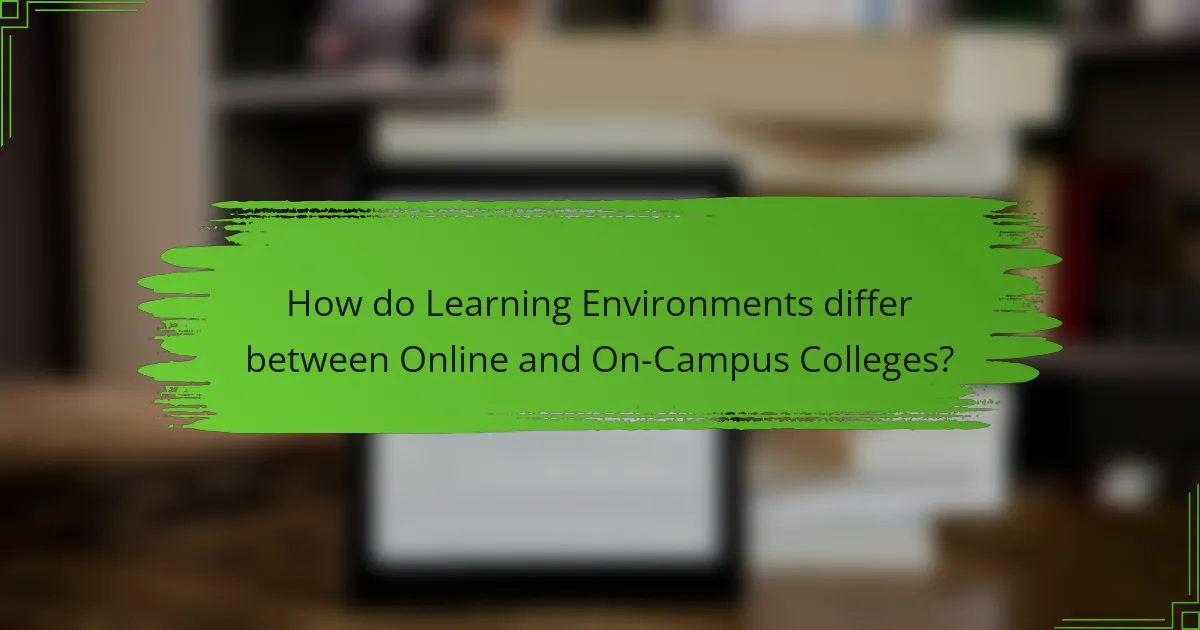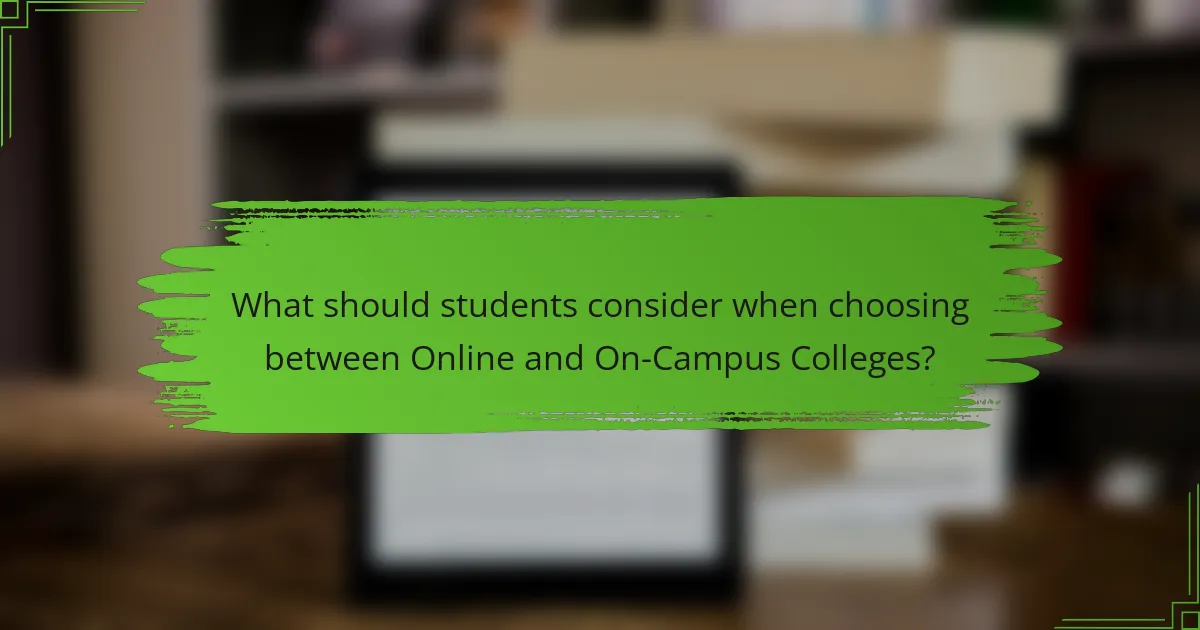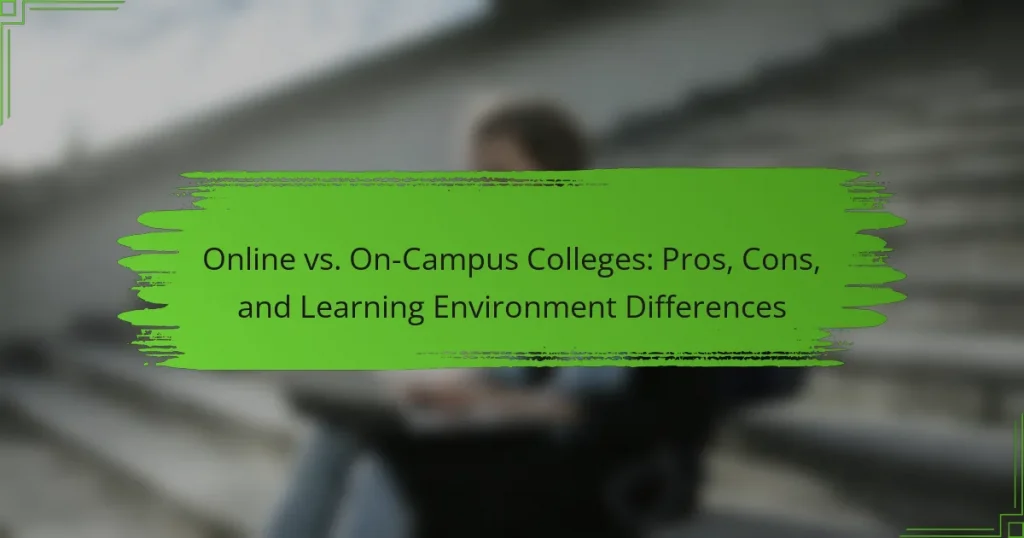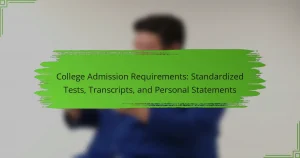
What are Online and On-Campus Colleges?
Online colleges are educational institutions that offer degree programs primarily through the internet. Students can attend classes and complete assignments remotely. This format provides flexibility for those balancing work or family commitments. On-campus colleges, on the other hand, require students to physically attend classes at a designated location. These institutions offer a traditional learning environment with face-to-face interaction. Both types of colleges can confer degrees, but their delivery methods differ significantly. Online colleges often cater to non-traditional students, while on-campus colleges typically attract traditional students. The choice between them depends on individual preferences and circumstances.
How do Online Colleges differ from On-Campus Colleges?
Online colleges primarily deliver education through digital platforms, while on-campus colleges provide in-person classroom experiences. Online colleges allow for flexible scheduling, accommodating students who may have work or family commitments. In contrast, on-campus colleges typically follow a set timetable for classes.
Additionally, online colleges often utilize a variety of multimedia resources for learning, such as videos and interactive modules. On-campus colleges usually rely on traditional lectures and face-to-face interactions.
Furthermore, online colleges can offer a wider range of programs to students in remote locations. On-campus colleges may have limited course offerings based on physical resources.
Lastly, online colleges often have lower overhead costs, which can translate into reduced tuition fees. On-campus colleges may incur higher expenses due to facilities and staff requirements.
What are the defining characteristics of Online Colleges?
Online colleges are educational institutions that offer degree programs primarily through the internet. They provide flexible learning schedules, allowing students to access course materials anytime and anywhere. Many online colleges utilize a variety of multimedia resources, including videos, discussion forums, and interactive assignments. Accreditation is a key characteristic, ensuring that the institution meets specific educational standards. Online colleges often emphasize self-directed learning, requiring students to manage their time effectively. They typically offer a wide range of programs, from associate degrees to advanced degrees. Additionally, online colleges may provide virtual support services, such as tutoring and counseling, to assist students. According to the National Center for Education Statistics, enrollment in online courses has significantly increased over the past decade, reflecting their growing popularity.
What are the defining characteristics of On-Campus Colleges?
On-campus colleges are characterized by their physical presence on a designated campus. They offer in-person classes and hands-on learning experiences. Students engage directly with faculty and peers in a shared environment. Facilities such as libraries, laboratories, and recreational areas are commonly available. On-campus colleges often provide a structured schedule with set class times. They facilitate extracurricular activities and social events for student engagement. Residential options are frequently offered, allowing students to live on campus. This setup fosters a sense of community and belonging among students.
What are the common advantages of Online and On-Campus Colleges?
Online and on-campus colleges offer flexibility and accessibility. Both formats allow students to balance education with work and personal commitments. Online colleges provide the convenience of studying from anywhere, while on-campus colleges foster in-person interaction and networking. Each option can cater to diverse learning styles. They also offer a range of programs and degrees. Both types of institutions are accredited, ensuring quality education. According to the National Center for Education Statistics, enrollment in online courses has grown significantly, reflecting their increasing popularity.
How does flexibility in scheduling impact students?
Flexibility in scheduling positively impacts students by allowing them to balance academic responsibilities with personal commitments. This flexibility enables students to manage work, family, and study time more effectively. Research indicates that students with flexible schedules report higher levels of satisfaction and lower stress levels. A study published in the Journal of Educational Psychology found that flexible scheduling correlates with improved academic performance. Students can choose when to study, which leads to better retention of information. Additionally, flexibility accommodates diverse learning styles and paces. This adaptability is particularly beneficial for non-traditional students who may have other obligations. Overall, flexible scheduling enhances the educational experience and supports student success.
What financial benefits do Online and On-Campus Colleges offer?
Online and on-campus colleges offer various financial benefits. Online colleges often have lower tuition fees compared to traditional institutions. This is due to reduced overhead costs associated with physical campuses. Additionally, online students save on commuting and housing expenses. On-campus colleges may provide financial aid, scholarships, and grants. In 2021, the College Board reported that 85% of full-time undergraduate students received some form of financial aid. Both types of colleges can also offer flexible payment plans. This allows students to manage their finances more effectively. Overall, choosing between online and on-campus options can significantly impact a student’s financial situation.
What are the potential drawbacks of Online and On-Campus Colleges?
Online and on-campus colleges both have potential drawbacks. Online colleges may lack face-to-face interaction, which can hinder networking opportunities. Students might also struggle with self-discipline and time management in an online environment. Technical issues can disrupt learning, creating additional stress.
On-campus colleges may involve higher costs due to tuition and living expenses. Commuting can be time-consuming and inconvenient for students. Additionally, on-campus students may experience distractions from social activities. Both formats can lead to feelings of isolation if students do not engage actively.
What challenges do students face in Online learning environments?
Students face several challenges in online learning environments. One major challenge is a lack of direct interaction with instructors. This can lead to misunderstandings and decreased engagement. Another challenge is time management. Students often struggle to balance coursework with personal responsibilities. Technical issues also pose significant barriers. Slow internet connections can disrupt learning experiences. Additionally, students may experience feelings of isolation. This can affect motivation and mental health. Lastly, the absence of structured schedules can hinder discipline. According to a study by the Online Learning Consortium, 70% of online students report difficulties in staying motivated.
What limitations do On-Campus Colleges present?
On-campus colleges present several limitations. One significant limitation is geographical restriction. Students must reside near the campus, which can limit enrollment to local individuals. Another limitation is the cost. On-campus colleges often have higher tuition and additional fees for housing and meals. Limited course availability can also be a challenge. Some programs may not be offered every semester, delaying graduation.
Scheduling conflicts arise frequently as well. Traditional class times may not accommodate students with jobs or family obligations. Additionally, on-campus colleges may lack flexibility in learning formats. Many do not offer online options, limiting access for non-traditional students.
Finally, on-campus colleges can foster a competitive environment. This may lead to increased stress among students. These factors collectively contribute to the limitations of on-campus colleges.

How do Learning Environments differ between Online and On-Campus Colleges?
Learning environments differ significantly between online and on-campus colleges. Online colleges offer flexibility, allowing students to learn at their own pace and schedule. This format often includes video lectures, discussion boards, and digital assignments. On-campus colleges provide structured schedules with face-to-face interactions. Students attend lectures, participate in group activities, and access campus facilities.
Research indicates that 70% of online learners report higher satisfaction with flexibility. Conversely, on-campus students often benefit from direct support and networking opportunities. A study by the National Center for Education Statistics shows that 85% of on-campus students feel more engaged in their learning environment. These differences shape the overall educational experience and outcomes for students in each format.
What are the key differences in student engagement?
Student engagement differs significantly between online and on-campus colleges. On-campus students often experience face-to-face interaction, fostering a sense of community. This can lead to higher motivation and participation in activities. Online students typically engage through digital platforms, which may limit personal connections. The flexibility of online courses can enhance engagement for self-motivated learners. However, it may also result in feelings of isolation for some. Research indicates that on-campus students report higher satisfaction levels due to direct access to resources and support systems. In contrast, online students benefit from the convenience of learning at their own pace.
How does interaction with instructors vary in Online vs. On-Campus settings?
Interaction with instructors varies significantly between online and on-campus settings. In on-campus environments, students often have face-to-face interactions with instructors. This allows for immediate feedback and personal engagement. Students can ask questions during or after lectures in real-time. Additionally, office hours provide opportunities for direct communication.
In contrast, online settings rely heavily on digital communication tools. Students interact through emails, discussion boards, and video calls. This method can lead to delayed responses compared to in-person interactions. Online platforms may lack the personal touch found in face-to-face meetings.
Research indicates that students in on-campus settings report higher satisfaction with instructor interaction. A study by the National Center for Education Statistics found that 70% of on-campus students felt they received adequate support from instructors. In comparison, only 50% of online students reported similar satisfaction levels. This data highlights the differences in interaction quality and frequency between the two learning environments.
What role does peer interaction play in learning experiences?
Peer interaction significantly enhances learning experiences by fostering collaboration and engagement. It allows students to share diverse perspectives and knowledge. This interaction promotes critical thinking and problem-solving skills. Research indicates that students who engage with peers demonstrate improved retention of information. A study by Johnson and Johnson (1994) highlighted that cooperative learning leads to higher achievement. Peer feedback also aids in refining understanding and skills. Furthermore, social interaction can increase motivation and accountability among students. Overall, peer interaction is essential for effective learning in both online and on-campus environments.
How do resources and support systems compare?
Resources and support systems in online and on-campus colleges differ significantly. On-campus colleges typically offer in-person resources such as libraries, academic advising, and mental health services. These resources facilitate direct interaction and immediate support for students. Online colleges provide digital resources, including online libraries, virtual tutoring, and remote counseling services. These services cater to students’ needs from anywhere, promoting flexibility.
On-campus support systems often include student organizations and networking opportunities. This fosters a sense of community and collaboration among students. Online colleges rely on forums and virtual communities to create connections among students. However, these interactions may lack the depth of face-to-face engagement.
According to a study by the National Center for Education Statistics, 71% of on-campus students reported satisfaction with their support services. In contrast, only 55% of online students expressed similar satisfaction. This indicates that the effectiveness of resources and support systems can vary based on the learning environment.
What academic resources are available to Online students?
Online students have access to a variety of academic resources. These include digital libraries that provide e-books, journals, and research articles. Many institutions offer online tutoring services for additional academic support. Students can also access course management systems for materials and assignments. Virtual study groups and discussion forums facilitate peer collaboration. Academic advising is often available through video calls or chat. Additionally, online students may utilize writing centers for assistance with papers. These resources enhance the learning experience and support academic success.
What support services do On-Campus Colleges provide?
On-campus colleges provide various support services to enhance student experience. These services include academic advising, which helps students plan their courses and career paths. Mental health services offer counseling and support for emotional well-being. Tutoring centers provide assistance in various subjects to improve academic performance. Career services help students with job placements and internships. Financial aid offices assist with scholarships and loan applications. Health services offer medical care and wellness programs. Student organizations promote community engagement and networking opportunities. These services contribute to a supportive learning environment, facilitating student success and personal development.

What should students consider when choosing between Online and On-Campus Colleges?
Students should consider several factors when choosing between online and on-campus colleges. Flexibility is a key attribute of online colleges, allowing students to manage their schedules. On-campus colleges offer structured environments that support face-to-face interaction. The cost of tuition can vary significantly between the two formats. Online programs often have lower overhead costs, which can translate to lower tuition rates. Accreditation is crucial; students should ensure their chosen program meets industry standards. Learning style is another important consideration; some students thrive in interactive, in-person settings, while others prefer the independence of online learning. Additionally, access to resources like libraries and labs may differ. On-campus colleges typically provide more hands-on experiences, which can be essential for certain fields. Overall, students should evaluate their personal needs and career goals to make an informed decision.
How can personal learning styles influence the choice?
Personal learning styles significantly influence the choice between online and on-campus colleges. Individuals with visual learning styles may prefer on-campus settings with physical materials and face-to-face interactions. Auditory learners might benefit from online lectures and discussions that they can listen to repeatedly. Kinesthetic learners often thrive in hands-on environments, which can be more readily available in on-campus courses. Research indicates that tailoring education to learning styles can enhance engagement and retention. A study published in the “Journal of Educational Psychology” found that students performed better when their learning preferences were aligned with instructional methods. This evidence supports the idea that personal learning styles directly impact educational choices.
What factors should students assess regarding their learning preferences?
Students should assess their learning preferences by considering their preferred learning style, environment, and pace. Learning styles include visual, auditory, and kinesthetic preferences. The learning environment encompasses factors such as classroom settings versus online platforms. Students should evaluate their comfort with technology and self-discipline in online learning. Additionally, they should consider the flexibility of schedules in relation to personal commitments. Research indicates that students with specific learning preferences often perform better in tailored educational settings. For example, a study by Felder and Silverman highlights the importance of matching teaching methods to students’ learning styles for improved academic outcomes.
How does motivation affect success in Online learning?
Motivation significantly affects success in online learning. High levels of motivation lead to better engagement with course materials. Motivated learners are more likely to complete assignments on time. They tend to participate actively in discussions and group activities. Research shows that intrinsic motivation correlates with higher academic performance. A study by Deci and Ryan (2000) highlights that motivation influences self-regulated learning. This self-regulation is crucial for managing time and setting goals. Students with strong motivation often achieve better outcomes in online environments.
What practical tips can help students make an informed decision?
Students can make informed decisions by thoroughly researching both online and on-campus colleges. They should assess their learning preferences and consider how each format aligns with their study habits. Evaluating the curriculum and course offerings is essential. Students must also consider the flexibility of schedules and location requirements.
Financial implications should be analyzed, including tuition costs and potential financial aid. Engaging with current students or alumni can provide valuable insights. Visiting campuses, if possible, helps gauge the environment and culture. Lastly, reviewing accreditation and program recognition is crucial for future career prospects.
How can students evaluate the credibility of Online Colleges?
Students can evaluate the credibility of online colleges by checking their accreditation status. Accreditation ensures that the institution meets specific educational standards. Students should verify if the college is accredited by a recognized accrediting agency. The U.S. Department of Education provides a database of accredited institutions. Additionally, students can research the college’s reputation through reviews and testimonials. They should also examine graduation rates and job placement statistics. These metrics often reflect the quality of education provided. Furthermore, students can contact alumni for firsthand experiences. This comprehensive approach helps ensure informed decisions about online college credibility.
What questions should students ask when visiting On-Campus Colleges?
Students should ask about the campus culture and community when visiting on-campus colleges. Understanding the social environment is crucial for their college experience. They should inquire about student organizations and activities available. This helps gauge engagement opportunities. Questions about academic support services are also important. Students need to know how institutions assist with tutoring and advising. They should ask about class sizes and student-to-faculty ratios. Smaller classes often lead to more personalized attention. Inquiring about housing options is essential for living arrangements. Students should also ask about safety measures on campus. Knowing how the college ensures student safety is vital. Finally, they should ask about internship and job placement opportunities. These factors significantly influence post-graduation success.
The main entity of this article is the comparison between online and on-campus colleges, focusing on their respective pros, cons, and learning environment differences. The article outlines the defining characteristics of both types of institutions, highlighting their delivery methods, student engagement, and available resources. It discusses the flexibility and accessibility offered by online colleges versus the structured, community-oriented experience of on-campus colleges. Additionally, it addresses financial considerations, potential drawbacks, and factors influencing student success in both environments, providing a comprehensive overview for prospective students to make informed decisions.




